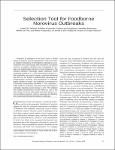Selection Tool for Foodborne Norovirus Outbreaks
Verhoef, Linda
Kroneman, Annelies
Duynhoven, Yvonne van
Boshuizen, Hendriek
Pelt, Wilfrid van
Koopmans, Marion
Koch, Judith
Schreier, Eckart
Stark, Klaus
Detection of pathogens in the food chain is limited mainly to bacteria, and the globalization of the food industry enables international viral foodborne outbreaks to occur. Outbreaks from 2002 through 2006 recorded in a European norovirus surveillance database were investigated for virologic and epidemiologic indicators of food relatedness. The resulting validated multivariate logistic regression model comparing foodborne (n = 224) and person-to-person (n = 654) outbreaks was used to create a practical web-based tool that can be limited to epidemiologic parameters for nongenotyping countries. Non-genogroup-II.4 outbreaks, higher numbers of cases, and outbreaks in restaurants or households characterized (sensitivity = 0.80, specificity = 0.86) foodborne outbreaks and reduced the percentage of outbreaks requiring source-tracing to 31%. The selection tool enabled prospectively focused follow-up. Use of this tool is likely to improve data quality and strain typing in current surveillance systems, which is necessary for identification of potential international foodborne outbreaks.
No license information

